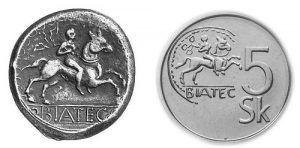Celtic Pride: Early Coinage as a Historical Record
Posted onToday we associate gold with investments and stores of wealth. However, a look at history reveals that gold had even more pragmatic uses. Some of the earliest Irish coinage served as payments from convicted criminals to victims or victims’ families. These early pieces of gold were rings, rather than coins. Coinage was a natural step in the evolution of economies. Celtic coinage was produced from the late second century B.C. to, approximately the mid-first century A.D.

Much of the early Irish and Celtic gold coin features were influenced by the Macedonian coinage of Philip II and Alexander the Great. The coins featured the head of Apollo from classic Greek and Roman religion. Apollo, with his youthful representation, is widely associated with music, truth, healing, and prophecy. The reverse often featured a horse-drawn chariot. Other coins show more gruesome images.
Some Celtic coins include representations of giants and severed heads on a rope. Other more dramatic images show soldiers on horses entering battle, gods, thunderbolts, or even skulls. Other coins showed symbols of good luck (gold stater of the Eburones). Such coins came from a tribe of Celtics called the Eburones. In fact, part of our understanding of the Eburones comes from the fact that concentrations of their coins have been found in et eastern part of the Dutch river area. The methods for minting these coins was surprisingly sophisticated given the limited technology of the time. Historians often make the distinction between coins that were “struck” versus those that were cast.
A struck coin starts as a blank and is stamped with an image using a die. Often, the die was formed with iron or bronze to withstand repeated use. A strong smithing operation, consisting of many professionals, could strike as many as 20,000 per day. In fact, at the height of production, ancient Romans could produce an astonishing 17 million in a year. The process was a trade including blacksmiths and apprentices. Like methods today, a struck coin required two dies, one for the front image, the other for the reverse. Eventually, modern technology gave way to innovations like roller mills which created metal sheets of uniform thickness. Mechanical minting operations would punch coins from this sheet. Moreover, these processes also gave rise to superior methods of generating precision alloys to ensure uniformity across coins. A cast, however, involves pouring the liquid metal into molds, so the coin image and shape are achieved in one step.
As the practice of minting became more commonplace, the designs on Celtic coins became more sophisticated. Horses became a regular image. Boar designs also became common as hunting was a regular practice. While many of these coins were gold or silver, Celtic coinage also included potin pieces consisting of tin and copper.
In time, the coins started to follow Roman imagery. This came as a result of Romans invading Gaul. Today, the coins that remain preserve an account of history that extends across a series of images that act as a record of victories and defeats.







